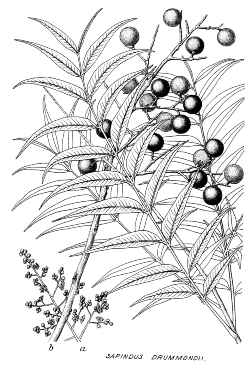Western Soapberry
Scientific Name: Sapindus saponaria var. drummondii (Hook. & Arn.) L. Benson
Synonym: Sapindus drummondii, Sapindus marginatus
Family: Sapindaceae

USDA: 6-9
Sun Exposure: Full sun to part shade
Origin: Southern USA (Louisiana to Arizona, north to southwestern Missouri), northern Mexico, along rivers and canyon sides
Growth Habits: Small deciduous tree, up to 25 to 50 feet tall (7.5-15 m), up to 30 feet wide or more (8 m); young bark smooth and gray-brown, aging scaly with deep gray furrows and reddish brown areas; alternate leaves, pinnately compound, 8 to 12 inches long (20-30 cm), with 9 to 15 lance-shaped, medium green glossy pointed leaflets above, slightly downy beneath, 2 to 3 inches long (5-7.5 cm)
Watering Needs: Little to moderate water, good drainage, drought resistant
Propagation: Seeds (pretreated and stratified), hardwood cuttings, transplants easily, occasionally produces root suckers
The common name comes from the fact that the crushed fruits have been used as laundry soap. The fruit is slightly poisonous.
Blooming Habits:
Small, yellowish-white to greenish-white flowers, in terminal, spike-shaped panicles, 5 to 10 inches long (12-25 cm), in late spring.
Fruiting Habits:
Translucent, yellowish orange fleshy drupe, up to 0.5 inch in diameter (1.2 cm), in grape-like clusters. The fruits ripen in fall but stay on the tree until spring. The fruits are produced only on the female trees.
Desert-Tropicals is dedicated to provide gardening advice, gardening ideas, and information about flower of all kind for landscape and collections.We try to check carefully the identification of the plants on the illustrations as well as the other information from the page, but occasionally errors do occur. if you notice anything that needs to be changed please contact us.Thanks.
© 1998-2020 Philippe Faucon, All Rights Reserved.